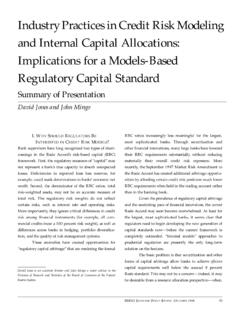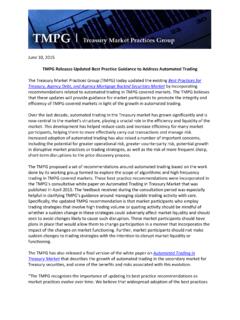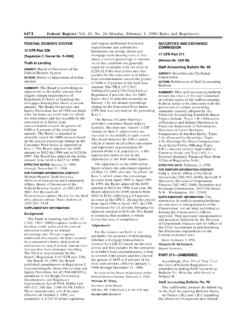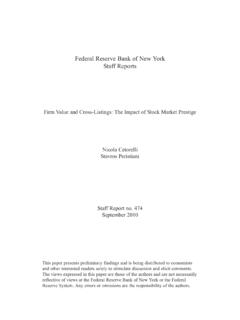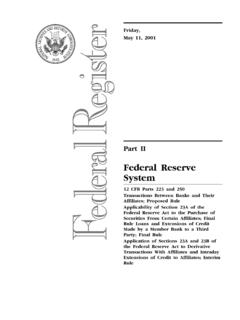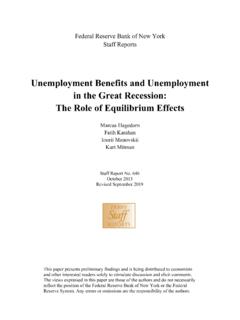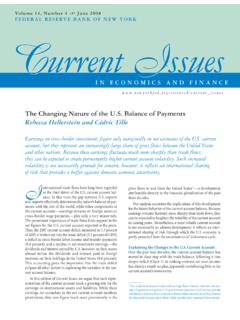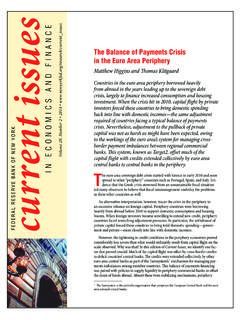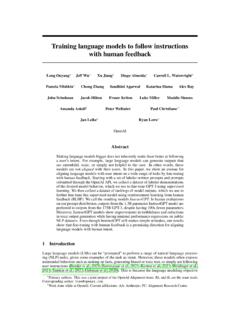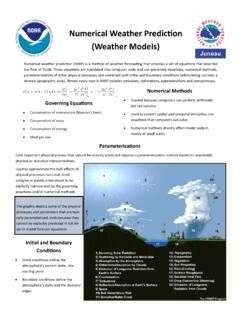Transcription of Policy Analysis Using DSGE Models: An Introduction
1 FRBNY Economic Policy Review / October 201023 Policy Analysis Using dsge Models: An recent years, there has been a significant evolution in the formulation and communication of monetary Policy at a number of central banks around the world. Many of these banks now present their economic outlook and Policy strategies to the public in a more formal way, a process accompanied by the Introduction of modern analytical tools and advanced econometric methods in forecasting and Policy simulations. Official publications by central banks that formally adopt a monetary Policy strategy of inflation targeting such as the Inflation Report issued by the Bank of England and the monetary Policy reports issued by the Riksbank and Norges Bank have progressively introduced into the Policy process the language and methodologies developed in the modern dynamic macroeconomic The development of medium-scale dsge (dynamic stochastic general equilibrium) models has played a key role in this These models are built on microeconomic foundations and emphasize agents intertemporal choice.
2 The dependence of current choices on future uncertain 1 The Bank of England has published a quarterly Inflation Report since 1993. The report sets out the detailed economic Analysis and inflation projections on which the Bank s Monetary Policy Committee bases its interest rate decisions. The Riksbank and Norges Bank each publish monetary Policy reports three times a year. These reports contain forecasts for the economy and an assessment of the interest rate outlook for the medium A simple exposition of this class of models can be found in Gal and Gertler (2007). Woodford (2003) provides an exhaustive textbook M. Sbordone is an assistant vice president and Andrea Tambalotti a senior economist at the Federal Reserve Bank of New York; Krishna Rao is a graduate student at Stanford University; Kieran Walsh is a graduate student at Yale : authors thank Ariel Zetlin-Jones for his contribution to the early stages of this work.
3 The views expressed are those of the authors and do not necessarily reflect the position of the Federal Reserve Bank of New York or the Federal Reserve System. Dynamic stochastic general equilibrium models are playing an important role in the formulation and communication of monetary Policy at many of the world s central banks. These models, which emphasize the dependence of current choices on expected future outcomes, have moved from academic circles to the policymaking community but they are not well known to the general public. This study adds to the understanding of the dsge framework by Using a small-scale model to show how to address specific monetary Policy questions; the authors focus on the causes of the sudden pickup in inflation in the first half of 2004.
4 An important lesson derived from the exercise is that the management of expectations can be a more effective tool for stabilizing inflation than actual movements in the Policy rate; this result is consistent with the increasing focus on central bankers pronouncements of their future M. Sbordone, Andrea Tambalotti, Krishna Rao, and Kieran WalshI24 Policy Analysis Using dsge Models: An Introductionoutcomes makes the models dynamic and assigns a central role to agents expectations in the determination of current macroeconomic outcomes. In addition, the models general equilibrium nature captures the interaction between Policy actions and agents behavior. Furthermore, a more detailed specification of the stochastic shocks that give rise to economic fluctuations allows one to trace more clearly the shocks transmission to the economy.
5 The use of dsge models as a potential tool for Policy Analysis has contributed to their diffusion from academic to policymaking circles. However, the models remain less well-known to the general public. To broaden the understanding of these models, this article offers a simple illustration of how an estimated model in this class can be used to answer specific monetary Policy questions. To that end, we introduce the structure of dsge models by presenting a simple model , meant to flesh out their distinctive features. Before proceeding to a formal description of the optimization problems solved by firms and consumers, we use a simple diagram to illustrate the interactions among the main agents in the economy. With the theoretical structure in place, we discuss the features of the estimated model and the extent to which it approximates the volatility and comovement of economic time series.
6 We also discuss important outcomes of the estimation namely, the possibility of recovering the structural shocks that drive economic fluctuations as well as the historical behavior of variables that are relevant for Policy but are not directly observable. We conclude by applying the dsge tool to study the role of monetary Policy in a recent episode of an increase in inflation. The lesson we emphasize is that, while they are a very stylized representation of the real economy, dsge models provide a disciplined way of thinking about the economic outlook and its interaction with We work with a small model in order to make the transmission mechanism of monetary Policy , whose basic contours our model shares with most dsge specifications, as transparent as possible.
7 Therefore, the model focuses on the behavior of only three major macroeconomic variables: inflation, GDP growth, and the short-term interest rate. 3 Adolfson et al. (2007) offer a more extended illustration of how dsge models can be used to address questions that policymakers confront in practice. Erceg, Guerrieri, and Gust (2006) illustrate Policy simulations with an open-economy dsge , the basic framework that we present could easily be enriched to provide more details on the structure of the economy. In fact, a key advantage of dsge models is that they share core assumptions on the behavior of households and firms, which makes them easily scalable to include details that are relevant to address the question at hand. Indeed, several extensions of the basic framework presented here have been developed in the literature, including the Introduction of wage stickiness and frictions in the capital accumulation process (see the popular model of Smets and Wouters [2007]) and a treatment of wage bargaining and labor market search (Gertler, Sala, and Trigari 2008).
8 4 Recently, the 2008 financial crisis has highlighted one key area where dsge models must develop: the inclusion of a more sophisticated financial intermediation sector. There is a large body of work under way to model financial frictions within the baseline dsge framework work that is very promising for the study of financial intermediation as a source and conduit of shocks as well as for its implications for monetary Policy . However, this last generation of models has not yet been subjected to extensive empirical Analysis . Our study is organized as follows. Section 2 describes the general structure of our model while Section 3 illustrates its construction from microeconomic foundations. Section 4 briefly describes our approach to estimation and presents some of the model s empirical properties.
9 In Section 5, we use the model to analyze the inflationary episode of the first half of 2004. Section 6 concludes. 2. dsge Models and Their Basic StructureDynamic stochastic general equilibrium models used for Policy Analysis share a fairly simple structure, built around three interrelated blocks: a demand block, a supply block, and a 4 Some of these larger dsge models inform Policy Analysis at central banks around the world: Smets and Wouters (2007) of the European Central Bank; Edge, Kiley, and Laforte (2008) of the Federal Reserve System; and Adolfson et al. (2008) of the article offers a simple illustration of how an estimated [ dsge ] model .. can be used to answer specific monetary Policy questions. A key advantage of dsge models is that they share core assumptions on the behavior of households and firms, which makes them easily scalable to include details that are relevant to address the question at Economic Policy Review / October 201025 ProductivityshocksDemandshocksPolicyshoc ksYe, ExpectationsY = fY( Y , i - e.)
10 Demandi = fi( *,Y,..)Monetary policyMark-upshocks = f ( ,Y,..)SupplyThe Basic Structure of dsge ModelsYee e emonetary Policy equation. Formally, the equations that define these blocks derive from microfoundations: explicit assumptions about the behavior of the main economic actors in the economy households, firms, and the government. These agents interact in markets that clear every period, which leads to the general equilibrium feature of the models. Section 3 presents the microfoundations of a simple dsge model and derives the equations that define its equilibrium. But first, we begin by introducing the basic components common to most dsge models with the aid of a diagram. In the diagram, the three interrelated blocks are depicted as rectangles. The demand block determines real activity as a function of the ex ante real interest rate the nominal rate minus expected inflation and of expectations about future real activity.
